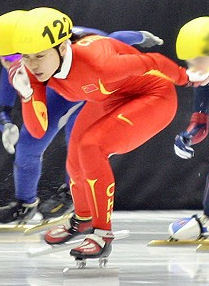
As with many sports, power in skating starts from the core muscles. To put pressure in to the ice through the blade the pressure starts by engaging your abdominal muscles, which then activates the hips and glutes, then delivers power through the quads and hams, then the lower leg, and finally the foot.
The article on Presscoopinchpushpinish – December 2009 will help to describe how the abdominals are used in skating. Using the abs allows for greater stability and more time to build pressure before you push the pressure through hips and glutes.
Notice in the photo to the right the athlete has her shoulders down and rounded, her entire back is round, and her hips (butt) are tucked under her. You can see that she has her mid abdominal muscles sucked up slightly towards her spine. As she recovers her leg under her the scoop in the mid belly rises even higher and her shoulders and hips round even more.
In the videos of Meng Wang and Victor Ahn you can see how they take their time to fully contract all of the abdominal muscles to gather the shoulders towards the hips and the hips towards the shoulders to activate the core muscles to start the push. And they continue to bring their hips forward during the push. Activating in this way through the core allows better and stronger connections to the hip and glute muscles.
The article on Presscoopinchpushpinish – December 2009 will help to describe how the abdominals are used in skating. Using the abs allows for greater stability and more time to build pressure before you push the pressure through hips and glutes.
Notice in the photo to the right the athlete has her shoulders down and rounded, her entire back is round, and her hips (butt) are tucked under her. You can see that she has her mid abdominal muscles sucked up slightly towards her spine. As she recovers her leg under her the scoop in the mid belly rises even higher and her shoulders and hips round even more.
In the videos of Meng Wang and Victor Ahn you can see how they take their time to fully contract all of the abdominal muscles to gather the shoulders towards the hips and the hips towards the shoulders to activate the core muscles to start the push. And they continue to bring their hips forward during the push. Activating in this way through the core allows better and stronger connections to the hip and glute muscles.

I will divide the abdominal muscles in to 3 segments to better understand how to activate each to build pressure.
The upper abs are activated by pulling the muscles under the rib cage up towards the shoulders and in towards the spine. This rounds the upper back and keeps the shoulders down. This is especially important when fighting encountering centrifugal force on the corner.
The mid abs are activated by sucking the muscles around the belly button in towards the spine. This keeps the middle back round.
The lower abs are activated by pulling your pelvis up towards your chin, as in a pelvic tilt. It is the activation of the lower abs which engage the muscles around the hip and glutes. Without activating the lower abs, basically all your power comes from your outer quads, resulting in a substantial loss in potential power and results in early fatiguing of the quads.
The upper abs are activated by pulling the muscles under the rib cage up towards the shoulders and in towards the spine. This rounds the upper back and keeps the shoulders down. This is especially important when fighting encountering centrifugal force on the corner.
The mid abs are activated by sucking the muscles around the belly button in towards the spine. This keeps the middle back round.
The lower abs are activated by pulling your pelvis up towards your chin, as in a pelvic tilt. It is the activation of the lower abs which engage the muscles around the hip and glutes. Without activating the lower abs, basically all your power comes from your outer quads, resulting in a substantial loss in potential power and results in early fatiguing of the quads.
The following skating specific exercises teach you how to actively recruit each one of the segments of the abdominal wall and are great to use as specific warm up exercises.
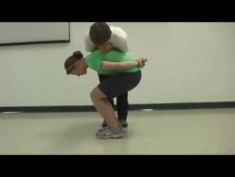 Click image to watch video
Click image to watch video
Abs push down: mid abs watch video
This drill activates mainly the mid abdominal muscles, although each segment is continually working. Assume your basic position with your feet pointing straight ahead and about shoulder width apart. Your shoulders are down and rounded so that your sternum is facing the floor. Your butt is tucked under you so that your butt bones are facing the floor. Knees should be over top of toes. Make sure your mid abdominals are raised up hard towards your spine and keep them pushing up through the exercise. Your partner waits until you give the go ahead that you are ready and then starts applying pressure on to the highest part of your back by laying across your back with their forearms and pushing down. Your job is not to so much push up with your legs but to prevent your partner pushing you down. It is your mid abs that should be resisting being pushed down and not your legs. The more pressure they apply, the more you will have to resist using your mid abs. Skaters can really take a lot of weight if this is done properly, ie: full body weight. Now try it not engaging your abs and see how easily you are pushed down.
This drill activates mainly the mid abdominal muscles, although each segment is continually working. Assume your basic position with your feet pointing straight ahead and about shoulder width apart. Your shoulders are down and rounded so that your sternum is facing the floor. Your butt is tucked under you so that your butt bones are facing the floor. Knees should be over top of toes. Make sure your mid abdominals are raised up hard towards your spine and keep them pushing up through the exercise. Your partner waits until you give the go ahead that you are ready and then starts applying pressure on to the highest part of your back by laying across your back with their forearms and pushing down. Your job is not to so much push up with your legs but to prevent your partner pushing you down. It is your mid abs that should be resisting being pushed down and not your legs. The more pressure they apply, the more you will have to resist using your mid abs. Skaters can really take a lot of weight if this is done properly, ie: full body weight. Now try it not engaging your abs and see how easily you are pushed down.
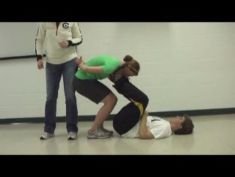 Click image to watch video
Click image to watch video
Abs push up: upper abs watch video
This one is for the upper abs. Your partner positions himself with his feet raised in a lying leg press position. You then take your basic position with your feet close to his butt and your shoulders over his feet. Engage all of your ab muscles making sure the ones under your rib cage are sucked up to your spine and your shoulders are rounded. Your partner then applies pressure pushing directly up (NOT BACK). You will really have to keep your rib cage muscles sucked in and engaged to prevent your shoulders being pried open. It is best to do this with someone bracing your butt behind you or do it against a wall so you don’t get pushed backwards.
This one is for the upper abs. Your partner positions himself with his feet raised in a lying leg press position. You then take your basic position with your feet close to his butt and your shoulders over his feet. Engage all of your ab muscles making sure the ones under your rib cage are sucked up to your spine and your shoulders are rounded. Your partner then applies pressure pushing directly up (NOT BACK). You will really have to keep your rib cage muscles sucked in and engaged to prevent your shoulders being pried open. It is best to do this with someone bracing your butt behind you or do it against a wall so you don’t get pushed backwards.
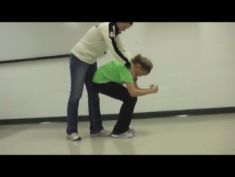 Click image to watch video
Click image to watch video
Variation of push up: ab pull open watch video
A variation of the ab push up is the ab pull open. Your partner stands behind you and braces your butt while trying to pry your chest up.
A variation of the ab push up is the ab pull open. Your partner stands behind you and braces your butt while trying to pry your chest up.
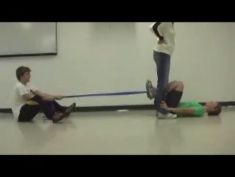 Click image to watch video
Click image to watch video
Strap pull in: lower abs watch video
This covers all sections of the abs but is particularly intense on the lower abs as your feet are pulled out and your legs straighten. Tie a strap around both feet. Start with your legs straight and your feet about 2 inches off the floor. Your partner pulls on the strap to provide resistance while you bring your knees in toward your chest keeping your feet low. Pull all the way in. You then try to prevent your partner from pulling your legs back out to a straightened position. Note as your knees pass the perpendicular position on the way back out how much you are having to work your lower abs.
This covers all sections of the abs but is particularly intense on the lower abs as your feet are pulled out and your legs straighten. Tie a strap around both feet. Start with your legs straight and your feet about 2 inches off the floor. Your partner pulls on the strap to provide resistance while you bring your knees in toward your chest keeping your feet low. Pull all the way in. You then try to prevent your partner from pulling your legs back out to a straightened position. Note as your knees pass the perpendicular position on the way back out how much you are having to work your lower abs.
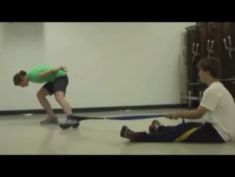 Click image to watch video
Click image to watch video
Strap recovery pull in: lower abs watch video
This exercise requires all of your abdominal muscles to be engaged in basic position, so make sure to start with you upper abs under your rib cage, your mid abs sucked in to your spine, and your lower abs pulling up toward your chin (not too much initially or it will throw you too far back on your heels). Make sure your shoulders are down and rounded and your butt cheeks are facing the floor. Tie a strap around your ankle (you may want to put some padding around your ankle) and start in a finish of push position with your leg straight out to the side, toe pointing straight ahead. Now lift your foot slightly off the floor and go through your recovery, bringing your thigh to the back as in a normal recovery with your toe pointing down. Then pull your foot in right beside your other foot so it is about 2 inches off the ground, foot parallel to the floor, and hold that position. Make sure not to change your position on your support leg as you go through your recovery. Try it first with no resistance so you get a feel for maintaining position on the other leg and for the recovery. Then have your partner apply light resistance through the motion, increasing the resistance once you start to pull your thigh in towards your support leg from the perpendicular recovery position. You will find that the more resistance there is, the more you have to engage your abs so you are not pulled over. You will also feel it on the outside of the balancing hip and thigh, and on the adductor on the pulling leg, as well as an increase of pressure in to the floor. A true test of your lower abs is to see how much resistance you can take when your feet are side by side (but not touching the floor). The more the resistance, the more you will have to pull in your lower abs. Notice in the video, it takes a long time for Mary to get her feet side by side and this only happens when she really pulls in her lower abs. This is the point where your partner can apply the most resistance.
This exercise requires all of your abdominal muscles to be engaged in basic position, so make sure to start with you upper abs under your rib cage, your mid abs sucked in to your spine, and your lower abs pulling up toward your chin (not too much initially or it will throw you too far back on your heels). Make sure your shoulders are down and rounded and your butt cheeks are facing the floor. Tie a strap around your ankle (you may want to put some padding around your ankle) and start in a finish of push position with your leg straight out to the side, toe pointing straight ahead. Now lift your foot slightly off the floor and go through your recovery, bringing your thigh to the back as in a normal recovery with your toe pointing down. Then pull your foot in right beside your other foot so it is about 2 inches off the ground, foot parallel to the floor, and hold that position. Make sure not to change your position on your support leg as you go through your recovery. Try it first with no resistance so you get a feel for maintaining position on the other leg and for the recovery. Then have your partner apply light resistance through the motion, increasing the resistance once you start to pull your thigh in towards your support leg from the perpendicular recovery position. You will find that the more resistance there is, the more you have to engage your abs so you are not pulled over. You will also feel it on the outside of the balancing hip and thigh, and on the adductor on the pulling leg, as well as an increase of pressure in to the floor. A true test of your lower abs is to see how much resistance you can take when your feet are side by side (but not touching the floor). The more the resistance, the more you will have to pull in your lower abs. Notice in the video, it takes a long time for Mary to get her feet side by side and this only happens when she really pulls in her lower abs. This is the point where your partner can apply the most resistance.
Thanks to Mary Grace, Chris Karow, Maria Karow, Sammy Holmes and Shannon Holmes for helping create the video for this tip.
For more core strength exercises see General Core Strength by Brandon Aldan – August 2008.
For more core strength exercises see General Core Strength by Brandon Aldan – August 2008.



